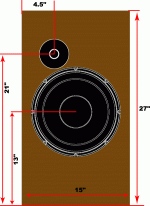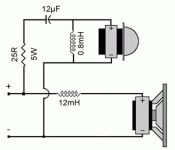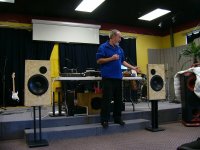Thread Index
Please go to posts #2500-2502 see the latest version of this project.
There you will find the current baffle plans and crossover schematics.
For explanations of how the crossover works, see post #1388
https://www.diyaudio.com/community/threads/fast-fun-inexpensive-ob-project.110583/post-4573958
For ideas on doing an active crossover see post #3006
https://www.diyaudio.com/community/threads/fast-fun-inexpensive-ob-project.110583/post-7033913
100Some time ago last year a speaker building buddy of mine in California decided to see what he could do in a simple, inexpensive, open baffle project. He came up with a 2 way passive system on a medium size baffle. He has been trotting them out at shows across the country and baffling a lot of folks who would never have thought so simple a concept could sound so good.
For your pleasure, here are the build specs on the Manzanita 12s:
To build each speaker you will need:
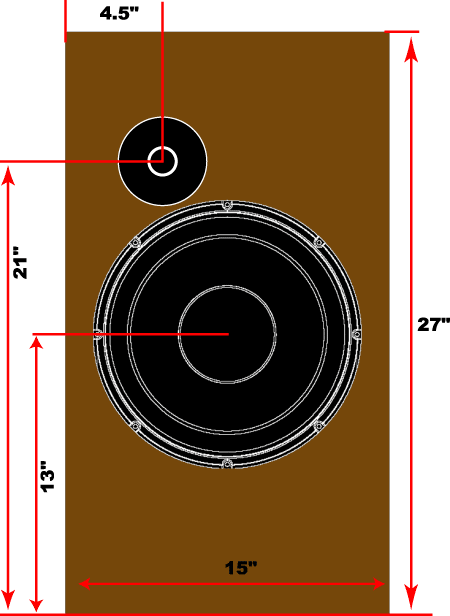
Total project parts cost is under $150 US per side, excluding wood. Or less than $300 for the pair. The drivers and parts are easy to find in the US, and should be as easy to find in Europe. As long as you keep the crossover values the same, feel free to substitute your favorite brands. Obviously, you will use the same drivers!
There may be plenty of forum denizens who will poke holes in this design without ever building it. No worries, that’s part of the DIY sport. Those who do build it will enjoy it, holes or not.
Why build this speaker? A few reasons:
Why NOT build this speaker?
Really, this project is so easy you can start after lunch and be finished in time to kick back, and enjoy the blues and some brews before dinner. The speakers throw a large soundstage, don’t suffer typical box coloration and have good tonal balance. The recessed midrange makes them very easy to listen to. But the midrange fills in nicely in the typical living room that is often a little over bright. With a good solid state or tube amp of 20 watts or more, you’ll have plenty of power. Even an AMP6 10 watt T-Amp runs these speakers to quite respectable volumes. A 20 watt tube amps has no trouble, despite the low sensitivity.
Continued in next post.....
Please go to posts #2500-2502 see the latest version of this project.
There you will find the current baffle plans and crossover schematics.
For explanations of how the crossover works, see post #1388
https://www.diyaudio.com/community/threads/fast-fun-inexpensive-ob-project.110583/post-4573958
For ideas on doing an active crossover see post #3006
https://www.diyaudio.com/community/threads/fast-fun-inexpensive-ob-project.110583/post-7033913
100Some time ago last year a speaker building buddy of mine in California decided to see what he could do in a simple, inexpensive, open baffle project. He came up with a 2 way passive system on a medium size baffle. He has been trotting them out at shows across the country and baffling a lot of folks who would never have thought so simple a concept could sound so good.
For your pleasure, here are the build specs on the Manzanita 12s:
To build each speaker you will need:
- Peerless SLS 830669 - 12" Woofer
- Seas 27TDFC tweeter
- Sledgehammer 12mH 15 gauge inductor
- 0.8 mH aircore inductor
- 12uF film capacitor
- 25 ohm 5W resistor
- Binding posts
- 3/4 wood for baffle, base and side wings. MDF or plywood, chipboard, etc.
Total project parts cost is under $150 US per side, excluding wood. Or less than $300 for the pair. The drivers and parts are easy to find in the US, and should be as easy to find in Europe. As long as you keep the crossover values the same, feel free to substitute your favorite brands. Obviously, you will use the same drivers!
There may be plenty of forum denizens who will poke holes in this design without ever building it. No worries, that’s part of the DIY sport. Those who do build it will enjoy it, holes or not.
Why build this speaker? A few reasons:
- It sounds good.
- It’s simple and easy to build.
- It plays well in an average size living room.
- It does not cost arm and a leg.
- Works well with most types of music.
- Very wide and deep soundstage.
- Easy to listen to – low fatigue.
- You’ve always wanted to try an open baffle design.
Why NOT build this speaker?
- Too simple. You need more of a challenge.
- Too cheap, you need to impress your friends.
- You like a hot midrange.
- You need ultimate finesse and flattest response.
- Your listening room is huge – or tiny.
- Your amp is a 2 watt SET-DHT job.
- You would rather go to the beach. (I understand…)
Really, this project is so easy you can start after lunch and be finished in time to kick back, and enjoy the blues and some brews before dinner. The speakers throw a large soundstage, don’t suffer typical box coloration and have good tonal balance. The recessed midrange makes them very easy to listen to. But the midrange fills in nicely in the typical living room that is often a little over bright. With a good solid state or tube amp of 20 watts or more, you’ll have plenty of power. Even an AMP6 10 watt T-Amp runs these speakers to quite respectable volumes. A 20 watt tube amps has no trouble, despite the low sensitivity.
Continued in next post.....
Attachments
Last edited by a moderator:
What can we learn by building this speaker?
First the baffles:
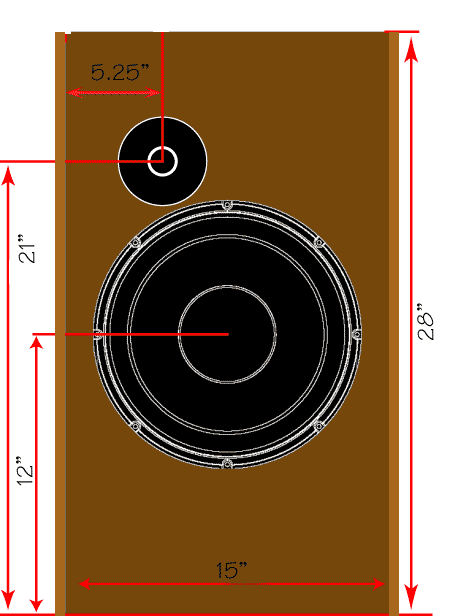
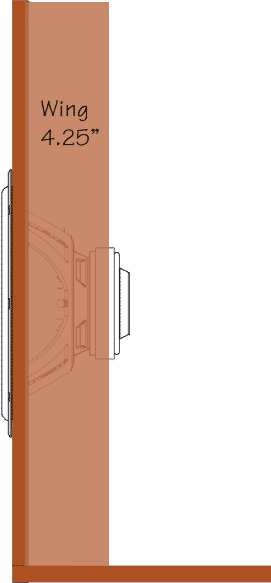
They are 15” wide by 27” tall. Chipboard, MDF, plywood etc. will do just fine. Mirror image tweeter placement for left and right.
Some sound deadening (simple automotive spray) should be put on the baffle back. Typically they sound balanced with the baffle face being from 30" - 38" from the rear wall and at least 36" from side walls. Only about 83 dB sensitivity at 1 kHz and -3 typically from around 40 Hz to 22 kHz on axis up to 14' of listening distance. You will want to elevate the baffle off the floor with a target height for the tweeter of 42", depending on your listening position.
It’s easy to build a speaker that sounds much better than it should, and much better than a lot of other speakers you’ve heard.
The importance of using good drivers that match each other. Both these drivers are of very good quality and work well together.
A simple crossover can work very well when properly implemented. There are some basic crossover tricks to be learned here.
Understand what has to be traded away and given up in a simple design and an open baffle design. What can be gained in a simple open baffle design.
First the baffles:


They are 15” wide by 27” tall. Chipboard, MDF, plywood etc. will do just fine. Mirror image tweeter placement for left and right.
Some sound deadening (simple automotive spray) should be put on the baffle back. Typically they sound balanced with the baffle face being from 30" - 38" from the rear wall and at least 36" from side walls. Only about 83 dB sensitivity at 1 kHz and -3 typically from around 40 Hz to 22 kHz on axis up to 14' of listening distance. You will want to elevate the baffle off the floor with a target height for the tweeter of 42", depending on your listening position.
Let’s look at the crossover.
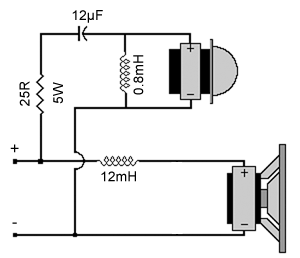
Drivers are electrically in phase. Woofer exhibits a 2nd order acoustic roll off at the top and no roll off on the bottom down to the mid 30's in a small to medium size room. (up to 2800 cu ft – 80 cu meters or so). They will sound best near field (8' to 14'). The tweeter has a forth order acoustic roll off around 1350 Hz. A pair will deliver clean sound on most recordings up to around 94-98 dB.
Why the big inductor? A 12mH inductor on an 8ohm driver is a first order low pass of about 105Hz. That’s seems awfully low to cross to a dome tweeter, right? But the idea here is to tilt the woofer response down to make up for the bass losses suffered in an open baffle design. If left alone or crossed at a more normal point, the 12” driver would have very little bass on an open baffle of this size. We need to “boost the bass.” The only way to do that with a passive filter is attenuate the high end. That’s where that part about throwing away certain things comes in. We throw away efficiency in the midrange to keep the low-end balance; otherwise the tonal balance of the 12 would be far too bright.
The big inductor does this FR tilt for us by pushing down the top end response - it’s an old trick for open baffle speakers. If you’re not using a box for the bass, you have to give up something. In this case we trade away efficiency.
The crossover on the tweeter looks a little more normal, a simple 2nd order high pass with attenuation. But there is some staggering of values from textbook values. This stagger helps bring the tweeter into phase with the woofer, among other things. The 25R resistor pads the tweeter down to the woofer’s midrange level.
The side wings of the baffle are asymmetrical to help smooth frequency response. Tweeter placement is also chosen for smooth response and to mate well with the woofer. Note that left and right baffles should be mirror images. The tweeters will be toward the inside edge when the speakers are in their playing position.
There are refinements that can be made to the basic design without much trouble. The drivers can be flush mounted, if you have the tools and the skill. Flush mounting should help refine the midrange. Baffle edges could be rounded over, which should also smooth out the mids, but maybe at the expense of a little bass response. And of course the crossover could be tweaked, but it will take a lot of experimentation or experience to get it better.
The 12” Peerless will jump up and grab you from time to time. On a hot vocal or piano the woofer cone can be pushed into break-up. You’ll hear it, no mistake. But it’s not all the time and isn’t too distracting. Fans of the Mamboni and EnABL treatments will likely find fertile ground in the Peerless 12. I suspect the EnABL process would clear up just about the entire bad behavior of the woofer.
So I advise you to go for it. Build a pair with scrap wood, just to get a feel for it. If you love them, make a prettier baffle. If you don’t love them, well, you’ll still have a set of nice drivers for your next project.
Drivers are electrically in phase. Woofer exhibits a 2nd order acoustic roll off at the top and no roll off on the bottom down to the mid 30's in a small to medium size room. (up to 2800 cu ft – 80 cu meters or so). They will sound best near field (8' to 14'). The tweeter has a forth order acoustic roll off around 1350 Hz. A pair will deliver clean sound on most recordings up to around 94-98 dB.
Why the big inductor? A 12mH inductor on an 8ohm driver is a first order low pass of about 105Hz. That’s seems awfully low to cross to a dome tweeter, right? But the idea here is to tilt the woofer response down to make up for the bass losses suffered in an open baffle design. If left alone or crossed at a more normal point, the 12” driver would have very little bass on an open baffle of this size. We need to “boost the bass.” The only way to do that with a passive filter is attenuate the high end. That’s where that part about throwing away certain things comes in. We throw away efficiency in the midrange to keep the low-end balance; otherwise the tonal balance of the 12 would be far too bright.
The big inductor does this FR tilt for us by pushing down the top end response - it’s an old trick for open baffle speakers. If you’re not using a box for the bass, you have to give up something. In this case we trade away efficiency.
The crossover on the tweeter looks a little more normal, a simple 2nd order high pass with attenuation. But there is some staggering of values from textbook values. This stagger helps bring the tweeter into phase with the woofer, among other things. The 25R resistor pads the tweeter down to the woofer’s midrange level.
The side wings of the baffle are asymmetrical to help smooth frequency response. Tweeter placement is also chosen for smooth response and to mate well with the woofer. Note that left and right baffles should be mirror images. The tweeters will be toward the inside edge when the speakers are in their playing position.
There are refinements that can be made to the basic design without much trouble. The drivers can be flush mounted, if you have the tools and the skill. Flush mounting should help refine the midrange. Baffle edges could be rounded over, which should also smooth out the mids, but maybe at the expense of a little bass response. And of course the crossover could be tweaked, but it will take a lot of experimentation or experience to get it better.
The 12” Peerless will jump up and grab you from time to time. On a hot vocal or piano the woofer cone can be pushed into break-up. You’ll hear it, no mistake. But it’s not all the time and isn’t too distracting. Fans of the Mamboni and EnABL treatments will likely find fertile ground in the Peerless 12. I suspect the EnABL process would clear up just about the entire bad behavior of the woofer.
So I advise you to go for it. Build a pair with scrap wood, just to get a feel for it. If you love them, make a prettier baffle. If you don’t love them, well, you’ll still have a set of nice drivers for your next project.
Attachments
Interesting design, I think the idea is very similar to where I have been going with my latest OB designs. If the spec's for the drivers are easily found on the Internet, it should be a simple simulation to run even including the passive crossover components. If I have time tonight I will see what I predict for a SPL response using one of my OB worksheet with passive crossovers.
Hi Panomaniac,
Wow, thanks very much. I'm intrigued by your description of the Manzanita's. The low cost/ easy build aspect surely is attractive to me.
The recessed midrange and occasional breakup mode that you described may not be a problem after all, but it 'flies in the face' of the conventional stuff that I've read and you also commented on.
I just had an interesting thought... IF I did build it and wanted to experiment with the drivers later in a different design, ie a 3way, I could maybe copy Omni's (g'day mate) 'Frankie'!
Thanks 'Pano', I'm sure things are great in Kihei! best wishes , grant
Wow, thanks very much. I'm intrigued by your description of the Manzanita's. The low cost/ easy build aspect surely is attractive to me.
The recessed midrange and occasional breakup mode that you described may not be a problem after all, but it 'flies in the face' of the conventional stuff that I've read and you also commented on.
I just had an interesting thought... IF I did build it and wanted to experiment with the drivers later in a different design, ie a 3way, I could maybe copy Omni's (g'day mate) 'Frankie'!
Thanks 'Pano', I'm sure things are great in Kihei! best wishes , grant
Hi Martin,
I'd love to see what your sims show. There should be a pretty big hole in the mids, but you just don't notice it. Seems like average room response fills it in.
There was a bit of measurement done in the hotel room in Denver, dropped fast below the mids 30s, IIRC.
Hey Grant. Things are lovely here on the south shore of Maui, summer is over, so the weather is just right. 🙂
Yes, if you don't dig the project - but I think you will - you can always use the drivers elsewhere. They are both very nice. The Peerless is said to work well on a 3 cu ft sealed box or very well in a bigger ported box.
This is not a tooty-fruity, over thought design. It's simple, it works, it sounds great. Those who choose to build it will be surprised at how easy it is to get a great, musical speaker.
Here are links to the driver specs:
Seas 27FTDC Tweeter
Peerless 12"
I'd love to see what your sims show. There should be a pretty big hole in the mids, but you just don't notice it. Seems like average room response fills it in.
There was a bit of measurement done in the hotel room in Denver, dropped fast below the mids 30s, IIRC.
Hey Grant. Things are lovely here on the south shore of Maui, summer is over, so the weather is just right. 🙂
Yes, if you don't dig the project - but I think you will - you can always use the drivers elsewhere. They are both very nice. The Peerless is said to work well on a 3 cu ft sealed box or very well in a bigger ported box.
This is not a tooty-fruity, over thought design. It's simple, it works, it sounds great. Those who choose to build it will be surprised at how easy it is to get a great, musical speaker.
Here are links to the driver specs:
Seas 27FTDC Tweeter
Peerless 12"
Panomaniac, this is very interesting topic. Thank you.
I think that this project is for me 🙂
If I can find those XO parts, I will try Manzanita 12".
Sorry, my english is not perfect...
I think that this project is for me 🙂
If I can find those XO parts, I will try Manzanita 12".
Sorry, my english is not perfect...
panomaniac,
I have the simulation running but something does not look right. Basically the tweeter has an efficiency of about 75 dB/W/m with the series resistor. You specified "25 ohm 5W resistor", could this be 5 ohm 25 W? Is this a typo?
I have the simulation running but something does not look right. Basically the tweeter has an efficiency of about 75 dB/W/m with the series resistor. You specified "25 ohm 5W resistor", could this be 5 ohm 25 W? Is this a typo?
miccomacho said:If I can find those XO parts, I will try Manzanita 12".
Sorry, my english is not perfect...
Seems OK to me!
You should easily find all you need except maybe the big inductor. It's a hog. 🙂
MJK said:You specified "25 ohm 5W resistor", could this be 5 ohm 25 W? Is this a typo?
Probably is a typo. I'll double check. Thanks for catching that, Martin.
Love the simplicity of this, my only concern is the efficiency, but you can't have it all....
I think 25 ohms is about right actually, if the 12mH causes a drop off of 6dB/oct, at the xover freq the woofer should be around 20 dB down. Of course this will be offset by the rising response beacause no zobel is used, the calculator here
http://www.sengpielaudio.com/calculator-Lpad.htm
gives 13.7dB attenuation using the quoted min Z of 6.5 ohms + 25ohms in series
5 ohms only gives around 5dB, which would probably be way too hot in this speaker...???
cheers,
Pete McK
I think 25 ohms is about right actually, if the 12mH causes a drop off of 6dB/oct, at the xover freq the woofer should be around 20 dB down. Of course this will be offset by the rising response beacause no zobel is used, the calculator here
http://www.sengpielaudio.com/calculator-Lpad.htm
gives 13.7dB attenuation using the quoted min Z of 6.5 ohms + 25ohms in series
5 ohms only gives around 5dB, which would probably be way too hot in this speaker...???
cheers,
Pete McK
PeteMcK said:Love the simplicity of this, my only concern is the efficiency, but you can't have it all....
Yeah, the low effciency is the monster in the closet. But trade offs always have to be made. That is why many open baffle speakers start with very efficient pro drivers. Trade off there is usually higher FS.
Still - these things come out to about 83dB/watt at 8 ohms. Maggies only get that at 4 ohms. A 20W tube amp does just fine on the Manzanitas.
Talked to JB, the designer. He says 25 ohms on the tweeter is correct. Why? Just because that's what worked! And I can tell you first hand the tonal balance was right, tweeter not MIA.
"You have to remember this is a DIPOLE, so there is a substantial rear contribution up to over 2K . [don't forget the] first and second harmonics that the woofer produces and the rear radiation of which is bouncing all around the room reinforcing the total presentation." Says JB.
If in doubt, buy yourself a big varible resistor and dial it up and down to find what works for you. 25R would be your starting point. At least that's what I think. 😉
I had the chance to hear the Manzanitas at the NCDIY meet on Saturday. JB was very articulate in presenting the design. They do indeed sound good, though they were handicapped by the room which was way too big for them.
Here's a pic of the speakers and their builder:
Here's a pic of the speakers and their builder:
Attachments
Hi Pano! I'm still intrigued with the Manzanitas...
Although I 'think' I have learnt a lot in this forum...maybe I still know zilch..or 'diddley-squat'?
The 830669 breakup still seems (to me) very difficult to control even with a 12mH choke. I've just been looking at the Peerless 8 Ohm 15" paper cone 830670 -->
http://www.tymphany.com/datasheet/printview.php?id=51
seems better behaved? I wonder if they would be feasible? Or even 2 by the 4 Ohm 830671's in series?
So many parameters to consider here, haha. I thought Qts > 1 was required for OB? Maybe this is why some OB designers opt for the Eminence Alpha/ Beta drivers?
Although I 'think' I have learnt a lot in this forum...maybe I still know zilch..or 'diddley-squat'?
The 830669 breakup still seems (to me) very difficult to control even with a 12mH choke. I've just been looking at the Peerless 8 Ohm 15" paper cone 830670 -->
http://www.tymphany.com/datasheet/printview.php?id=51
seems better behaved? I wonder if they would be feasible? Or even 2 by the 4 Ohm 830671's in series?
So many parameters to consider here, haha. I thought Qts > 1 was required for OB? Maybe this is why some OB designers opt for the Eminence Alpha/ Beta drivers?
Putting the SLS that high in the air sacrifices a lot of (possible) floor gain. On the other hand the tweeter needs to be near the woofer because the crossover frequency looks like anywhere between 1-2 k Ohm.
I would like to see the baffle reaching to the floor with a second SLS connected in parallel and mounted as low as possible. That one may be low-passed first order @100 Hz. May be Martin could have a look at it when simulating the Manzanita. 🙄
Rudolf
I would like to see the baffle reaching to the floor with a second SLS connected in parallel and mounted as low as possible. That one may be low-passed first order @100 Hz. May be Martin could have a look at it when simulating the Manzanita. 🙄
Rudolf
andrew01 said:I might be a bit *slow* in understanding , but , how would these have decent midrange ?
Psychoacoustic Jedi mind tricks? I don't know. 😕
Maybe the room fills in the mids via reflections.
Honestly, all of us who heard them answered "No" the the following question. "Do you find them too recessed in the midrange, too laid back?"
After listening to far too much, too many full range drivers, these came as a breath of fresh air. No, they do not have the most refined midrange in the world, but they also don't shout and bite your head off like a lot of "articulate" speakers do.
The proof of concept was that CDs were coming out with cries of "play this one, let me hear this one." A real fun speaker to listen to. Makes you want to listen to music.
Don't over think it. Just accept it for what it is. An easy speaker to build that will give you a lot of musical pleasure. Basta.
Rudolf said:I would like to see the baffle reaching to the floor with a second SLS connected in parallel and mounted as low as possible.
Absolutely! And I'm working on a project like that to be a low end "helper" for a fullrange driver. But that's a whole other story.
The concept of the Manzanita is "Most Bang for your Buck" They do it beautifully.
Hi Pano. I like the look of this one too. Maybe it is time to just listen to the music. I do agree with idea of a second 12" as a bass helper but was wondering about mounting this one in an enclosure to get it lower.
jamikl
jamikl
As promised, here are the simulation results for this design. The first page is the baseline calculations using the data above and the picture showing the speaker on a stand. The second page is a simulation with a Zobel added to the woofer and decreasing the series resistor for the tweeter from 25 to 10 ohms.
http://www.quarter-wave.com/Simulation_Results.pdf
I think that the design has some real potential. Basically, a passive crossover is possible by reducing the effective tweeter efficiency to 5 - 10 dB below the woofer efficiency. This is conistent with my OB design method article of a few weeks ago. I think more improvements in the response are possible by tweaking the crossover values a little bit.
Study completed, back to what I was working on a few day ago,
http://www.quarter-wave.com/Simulation_Results.pdf
I think that the design has some real potential. Basically, a passive crossover is possible by reducing the effective tweeter efficiency to 5 - 10 dB below the woofer efficiency. This is conistent with my OB design method article of a few weeks ago. I think more improvements in the response are possible by tweaking the crossover values a little bit.
Study completed, back to what I was working on a few day ago,
- Home
- Loudspeakers
- Multi-Way
- Fast, fun, Inexpensive OB project
